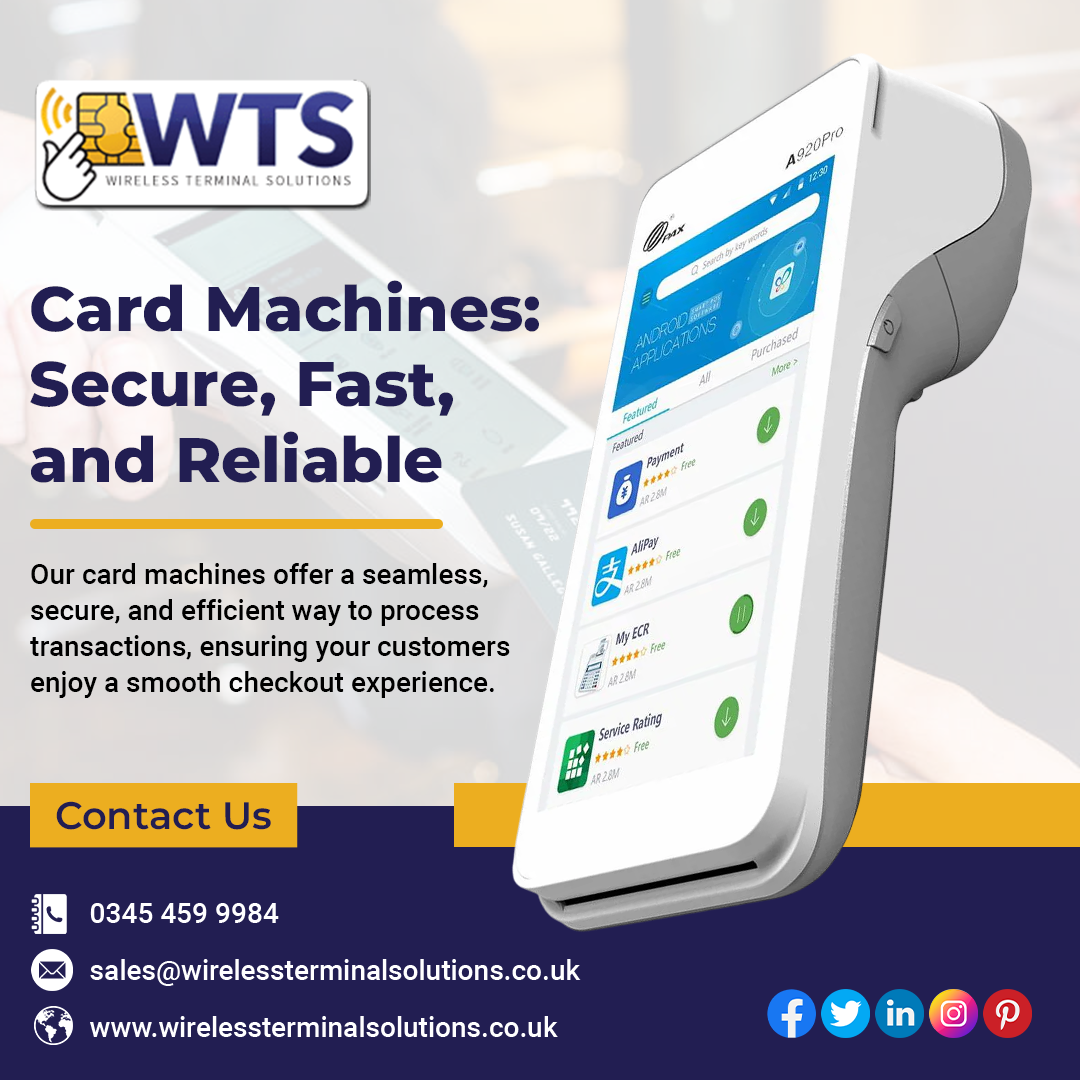Card Terminals vs Mobile Payments
Card Terminals vs Mobile Payments: What to Choose?
As the world rapidly shifts toward digital
transactions, businesses and consumers alike are re-evaluating how they handle
payments. Two prominent methods stand out in today's evolving payment
landscape: card terminals and mobile payments. While both are convenient
and widely accepted, they cater to different needs and preferences. Whether
you're a business owner deciding which option to adopt or a consumer curious
about how each works, this blog will help you understand the differences and
guide you in making an informed choice.
What Are Card
Terminals?
Card terminals,
card
machine often called point-of-sale (POS) machines, are electronic
devices used to process credit and debit card transactions. These machines
typically accept chip-and-PIN cards, magnetic stripe cards, and contactless
cards. Some newer models also accept mobile wallet payments.
Card terminals are
commonly seen in retail stores, restaurants, service counters, and more. They
offer a reliable and familiar way for customers to pay and for merchants to
collect payment efficiently.
Advantages of Card
Terminals
1.
Widely Accepted
Most consumers carry a debit or credit card, making card terminals a universal
payment solution.
2.
Fast and Reliable
With stable network connections (Wi-Fi, Ethernet, or SIM-based), transactions
are usually quick and consistent.
3.
Familiarity
Customers are comfortable using card terminals. They trust the process, and
little explanation is needed.
4.
Security Features
Many card terminals come with end-to-end encryption and secure PIN entry,
making them a safe choice for transactions.
5.
Paper Receipts
Many businesses still prefer providing printed receipts for returns, exchanges,
or record-keeping.
Disadvantages of
Card Terminals
1.
Initial Cost and
Maintenance
Businesses often need to purchase or rent the device and pay for upkeep or
software updates.
2.
Physical Space
Requirement
Card terminals require counter space and sometimes additional hardware like
receipt printers.
3.
Limited Mobility
Unless they are portable models, most card terminals are fixed to a specific
location.
What Are Mobile
Payments?
Mobile payments
refer to transactions made through smartphones, smartwatches, or tablets using
digital wallets or apps. These payments are contactless and processed through
technologies like NFC (Near Field Communication), QR codes, or peer-to-peer
(P2P) platforms.
Mobile payments
have surged in popularity, especially among younger demographics and in urban
areas, due to their speed and ease of use.
Advantages of
Mobile Payments
1.
Contactless and
Hygienic
Especially relevant in a post-pandemic world, mobile payments reduce physical
contact, making them a cleaner alternative.
2.
Convenience and
Speed
Users can complete transactions with just a tap or scan—no need to carry
physical cards or cash.
3.
Enhanced Features
Mobile apps often provide features like transaction history, budget tracking,
cashback offers, and loyalty rewards.
4.
Mobility for
Merchants
With the right app and device, vendors can accept payments anywhere, making
this ideal for mobile businesses and pop-up events.
5.
Lower Equipment
Costs
Accepting mobile payments may not require dedicated hardware, especially for
small businesses.
Disadvantages of
Mobile Payments
1.
Limited User
Adoption
Not everyone is comfortable using or has access to mobile payment technology,
particularly older generations.
2.
Battery and
Connectivity Dependence
Both the customer and the merchant need working devices and stable internet
connections.
3.
Security Concerns
While mobile payments can be secure, users must take extra precautions with
passwords, biometric locks, and app permissions.
4.
Compatibility
Issues
Not all mobile payment apps are compatible with every type of phone or
operating system.
Factors to
Consider When Choosing Between Them
1. Customer Demographics
If your target
audience consists mainly of tech-savvy individuals or younger customers, mobile
payments may be more appropriate. On the other hand, if your clientele prefers
traditional payment methods, card terminals are a safer bet.
2. Type of Business
For fixed-location
businesses like retail stores or salons, a card terminal & contactless
card machine for small business provides a stable and professional
checkout experience. For mobile businesses such as food trucks, market vendors,
or service professionals who travel, mobile payments offer unmatched
flexibility.
3. Transaction Volume
Card terminals are
designed to handle high volumes of transactions quickly and efficiently. If you
deal with many customers daily, this option may be more suitable. Mobile
payments can also manage high volumes but might not be as fast when network
issues arise.
4. Cost and Budget
If you're a small
business with tight capital, you might find mobile payment systems more
affordable since they may not require expensive hardware. Card terminals, while
reliable, often involve upfront and recurring costs.
5. Security and Compliance
Card terminals
usually meet strict industry standards for data protection and compliance.
Mobile payments can be just as secure, but only if both parties follow best
practices such as using up-to-date apps, strong authentication methods, and
secure networks.
The Hybrid
Approach: Why Not Both?
In today’s dynamic
marketplace, flexibility is key. Many businesses are choosing to offer both
card terminal and mobile payment options. This hybrid approach ensures that no
customer is turned away due to limited payment methods.
Offering multiple
payment options also enhances customer satisfaction and builds trust, showing
that your business is modern, adaptable, and customer-focused.
Final Thoughts
Card terminals
and mobile payments both have their unique strengths. Choosing the right
solution depends on your business type, customer preferences, and operational
needs.
·
Card
terminals are trusted, efficient, and well-suited for traditional
retail settings.
·
Mobile payments
offer flexibility, speed, and tech-forward appeal, especially for businesses on
the go.
Ultimately, the
best choice may not be one or the other—but both. Embracing multiple payment
options ensures you're ready for today's diverse and digital-savvy consumer
base.


Comments
Post a Comment